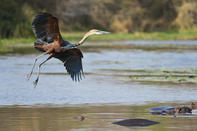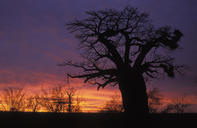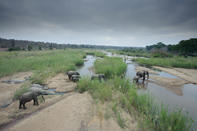Iconic Wilderness
Kruger is South Africa’s most iconic reserve. It’s a pristine wilderness that’s practically a country in itself. Kruger National Park is simply enormous.

It comprises nearly two-million hectares of South African bush and is also part of the Greater Limpopo Transfrontier Park – a peace park that links it to reserves in Mozambique and Zimbabwe. Kruger is home to an unrivalled density of life forms: 336 tree species, 49 fish, 34 amphibians, 114 reptiles, 507 birds and 147 mammals. Established in 1898 to protect the wildlife of the Lowveld, this national treasure is today a world leader in advanced environmental management techniques.
Africa's Eden

It’s an environment that you can lose yourself in, driving for days through an Eden-like wilderness. This is the realm of baobabs, fever trees, mopanes and leadwoods; a land patrolled by the Big Five, the Little Five (buffalo weaver, elephant shrew, leopard tortoise, ant lion and rhino beetle) and the birding Big Six (ground hornbill, kori bustard, lappet-faced vulture, martial eagle, Pel’s fishing owl and saddle-billed stork).
Kruger is primarily a self-drive and self-catering destination with good infrastructure that includes rest camps, picnic sites and hides. However, there are also tour operators and private concessions within the park. Most visitors are accommodated in thatched rondavels (the best ones are on the camps’ perimeters or facing a river). However, nine of the camps also provide campsites and a few have furnished safari tents and huts. For a more rustic experience, book into one of the bushveld camps, which are much smaller and basic.
Kruger's Grasslands

The southern part of Kruger has the greatest concentration of game and attracts the most visitors. The park’s headquarters is at Skukuza and has an airport, car rental, shops and accommodation for more than 1000 people. Central Kruger also has good game viewing and hosts two of the most attractive large camps: Olifants and Letaba.
The northern section has fewer animals and visitors and more of a wilderness feeling. Although game watching in the mopane forests can be tough, the rugged landscape and birding rewards along the Limpopo and Luvuvhu Rivers make up for it. The central Kruger is made up of a number of biomes, but is most famous for its grasslands which support enormous numbers of ungulates.. . and hence the highest lion population in the park.
Most of Kruger's larger raptors are also found here, as well as the biggest vulture population. These grasslands are contained in the east by the Lebombo mountains, while the western grasslands and woodlands are on granite soil, which does not have such good quality grazing. As you travel north towards Letaba, you move into mopane scrub – great for elephants, but unless you're following a watercourse, the animal sightings diminish.
At approximately 2 million hectares in size, the Kruger National Park easily dwarfs some smaller European countries. Unrivalled diversity when it comes to fauna and flora, plus a treasure trove of historical and archaeological sites, means this is as good as it gets in the great African outdoors.
The park itself boasts a range of experiences, from game viewing, mountain biking, hiking and bird watching, to ensure you get up close and personal with nature. Base yourself at a bigger camp like Skukuza if you require access to shops, doctors and other basic small town services.
By Justin Fox There is a wide variety of accommodation in Kruger National Park options ranging from rest camps to luxury Kruger Park safari lodges....
There is a wide variety of accommodation in Kruger National Park options ranging from rest camps to luxury Kruger Park safari lodges.... Baobab Hill - A distinctive landmark, this was the first outspan on the Witwatersrand Native Labour Association route to the Soutpansberg, 1...
Baobab Hill - A distinctive landmark, this was the first outspan on the Witwatersrand Native Labour Association route to the Soutpansberg, 1... Flights to the Kruger National Park land at the Kruger-Mpumalanga International Airport (KMIA). There is a bank and ATM at Skukuza rest camp...
Flights to the Kruger National Park land at the Kruger-Mpumalanga International Airport (KMIA). There is a bank and ATM at Skukuza rest camp... The Kruger National Park has strict speed limits: 50 kmph on tar roads and 40 kmph on gravel roads. It would be foolish to exceed these limi...
The Kruger National Park has strict speed limits: 50 kmph on tar roads and 40 kmph on gravel roads. It would be foolish to exceed these limi... Visitors with their own vehicles are welcome to enter the park and explore it for the day. This is a popular excursion for locals and people...
Visitors with their own vehicles are welcome to enter the park and explore it for the day. This is a popular excursion for locals and people... Wild animals in the Kruger National Park including 11 670 elephants, 150 000 impalas, 17 000 blue wildebeest, 9 000 giraffes, 3 000 hippos a...
Wild animals in the Kruger National Park including 11 670 elephants, 150 000 impalas, 17 000 blue wildebeest, 9 000 giraffes, 3 000 hippos a... A constant source of terror for many people, these poisonous beasties will probably not harm you as long as they don’t feel threatened. Th...
A constant source of terror for many people, these poisonous beasties will probably not harm you as long as they don’t feel threatened. Th...